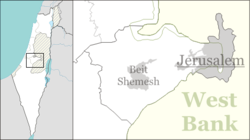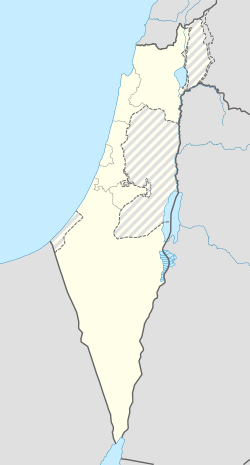Top Qs
Timeline
Chat
Perspective
Beit Zayit
Place in Jerusalem, Israel From Wikipedia, the free encyclopedia
Remove ads
Beit Zayit (Hebrew: בית זית, lit. 'House of Olives') is a moshav in central Israel. Located just outside the Jerusalem municipal border to the west, it falls under the jurisdiction of Mateh Yehuda Regional Council. In 2023 it had a population of 1,506.[1] Beit Zayit lies in the Judaean Mountains on the edge of the Jerusalem Forest, the artificial municipal pine forest planted in by the Jewish National Fund on the outskirts of West Jerusalem.
Remove ads
Etymology
A village named Beit Zayit is mentioned in the Books of the Maccabees, but it is believed to have been further north, possibly at the site of the Palestinian Christian town of Birzeit, north of Ramallah.[citation needed]
History
Beit Zayit was established in 1949, after the 1947-49 Arab-Israeli war on land that had belonged to the depopulated Palestinian village of 'Ayn Karim.[2] It was established in 1949 by Jewish immigrants from Egypt, Romania and Yugoslavia. The economy was based on fruit orchards, vegetables, poultry, and other farm products.[citation needed]
With the expansion of the moshav in the late 1990s, including the purchase of land by newcomers and renovation of old homes, Beit Zayit became a trendy alternative to living in Jerusalem.[3]
Remove ads
Landmarks
Beit Zayit Reservoir

Nearby is a dam, built to collect winter flood waters and create the Beit Zayit Reservoir, meant to slow down the flow of the Nahal Sorek and allow water to seep into the Western Mountain Aquifer, a task it seems has not been doing properly, due to insufficient geotechnical and hydrological studies in preparation to the project.[4]
Dinosaur footprints
In 1962, dinosaur footprints were discovered in the garden of one of Beit Zayit's residents, and are on display at the Hebrew University of Jerusalem.[5] This is the only place in Israel where evidence of dinosaurs was discovered, and one of few such sites in the Middle East.[6]
In popular culture
In the Israeli TV show Fauda, the village is visited by the main characters since one of the characters, Yaara, lives there.[7]
References
External links
Wikiwand - on
Seamless Wikipedia browsing. On steroids.
Remove ads



